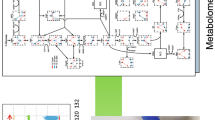Abstract
The metabolic flux pattern forl-histidine production was analyzed when glucose and/or acetate were used as carbon sources. Totall-histidine production was enhanced when mixed substrate (glucose and acetate) was used, compared with that when either glucose or acetate was used as the sole carbon source. Theoretical maximum carbon fluxes through the main pathways forl-histidine production, cell growth, and ATP consumption for cell maintenance were obtained by the linear programming (LP) method. By comparison of the theoretical maximum carbon fluxes with actual ones, it was found that a large amount of glucose was actually used for maintenance of cell viability. On the other hand, acetate was used for cell growth. After depletion of acetate in the mixed substrate culture, the flux for glucose tol-histidine synthesis was markedly enhanced. A strategy for effectivel-histidine production using both carbon sources was proposed.
Similar content being viewed by others
Abbreviations
- r i :
-
mole flux (i=1…13) (mole/h)
- r maxi :
-
theoretical maximum flux (mole/h)
- f i :
-
percentage of mole flux in three main pathways (%)
- His/Gluc:
-
histidine synthesis from glucose
- X/Gluc:
-
biomass synthesis from glucose
- mATP/Gluc:
-
ATP consumption for cell maintenance from glucose
- His/Ac:
-
histidine synthesis from acetate
- X/Ac:
-
biomass synthesis from acetate
- mATP/Ac:
-
ATP consumption for cell maintenance from acetate
References
Eggeling, L. and H. Sahm (1999) Amino acid production: principles of metabolic engineering, pp. 153–176 In: S. Y. Lee and E. T. Papoutsakis (eds.),Metabolic Engineering. Marcel Dekker Inc., New York, USA.
Mizutani, T., A. Hamu, M. Ikeda, K. Oka, and R. Katsumata (1994) Cloning of the ATP phosphoribosyl transferase gene ofCorynebacterium glutamicum and application of gene to L-histidine production.Biosci. Biotechnol. Biochem. 58: 635–638.
Chim-anage, P., S. Shioya, and K. Suga (1990) Optimum conditions for histidine production by fed-batch culture ofBrevibacterium flavum.J. Ferment Bioeng. 70: 386–391.
Chim-anage, P., S. Shioya, and K. Suga (1991) Maximum histidine production by fed-batch culture ofBrevibacterium flavum.J. Ferment. Bioeng. 71: 186–190.
Ishio, S., T. Kuga, K. Yamaguchi, K. Shirahata, and K. Araki (1986)13C NMR studies of histidine fermentation withCorynebacterium glutamicum mutant.Agr. Biol. Chem. 50: 307–310.
Wendisch, V. F., A. A. de Graaf, H. Sahm, and B. J. Eikmanns (2000) Quantitative determination of metabolic fluxes during co-utilization of two carbon sources: comparative analyses withCorynebacterium glutamicum during growth on acetate and/or glucose.J. Bacteriol. 182: 3088–3096.
Vallino, J. J. and G. Stephanopoulos (1993) Metabolic flux distribution inCorynebacterium glutamicum during growth and lysine overproduction.Biotechnol. Bieong. 41: 633–646.
Takiguchi, N., H. Shimizu, and S. Shioya (1997) An online physiological state recognition system for the lysine fermentation process on a metabolic reaction model.Biotechnol. Bioeng. 55: 170–181.
Stephanopoulos, G. and T. Simpson (1997) Flux amplification in complex metabolic networks.Chem. Eng. Sci. 52: 2607–2627.
Varma, A., B. W. Boesch, and B. O. Palsson (1993) Biochemical production capabilities ofEscherichia coli.Biotechnol. Bioeng. 42: 59–73.
Varma, A., B. W. Boesch, and B. O. Palsson (1993) Stoichiometric interpretation ofEscherichia coli glucose catabolism under various oxygenation rates.Appl. Environ. Microbiol. 59: 2465–2473.
van Gulik, W. M. and J. J. Heijnen (1995) A metabolic network stoichiometry analysis of microbial growth and product formation.Biotechnol. Bioeng. 48: 681–698.
Edwards, J. S. and B. O. Palsson (1998) How will bioin-formatics influence metabolic engineering.Biotechnol. Bioeng. 58: 162–169.
Schilling, C. H., J. S. Edwards, and B. O. Palsson (1999) Toward metabolic phenomics: Analysis of genomic data using flux balances.Biotechnol. Prog. 15: 288–295.
Mavrovouniotis, M. L. and G. Stephanopoulos (1990) Computer aided synthesis of biochemical pathways.Biotechnol Bioeng. 36: 1119–1132.
Chim-anage, P. (1991)A Bioengineering Approach for Maximum Histidine Production in Fed-batch Cluture. PhD thesis, Osaka University, Osaka, Japan.
Author information
Authors and Affiliations
Corresponding author
Rights and permissions
About this article
Cite this article
Shimizu, H., Shimizu, N. & Shioya, S. Roles of glucose and acetate as carbon sources inl-histidine production withBrevibacterium flavum FERM1564 revealed by metabolic flux analysis. Biotechnol. Bioprocess Eng. 7, 171–177 (2002). https://doi.org/10.1007/BF02932915
Received:
Accepted:
Issue Date:
DOI: https://doi.org/10.1007/BF02932915




